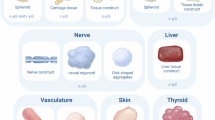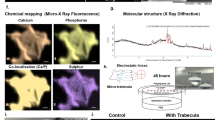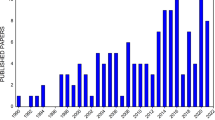Summary
Tissue engineering studies were done using isolated cells, three-dimensional polymer scaffolds, and rotating bioreactors operated under conditions of simulated microgravity. In particular, vessel rotation speed was adjusted such that 10 mm diameter × 2 mm thick cell-polymer constructs were cultivated in a state of continuous free-fall. Feasibility was demonstrated for two different cell types: cartilage and heart. Conditions of simulated microgravity promoted the formation of cartilaginous constructs consisting of round cells, collagen and glycosaminoglycan (GAG), and cardiac tissue constructs consisting of elongated cells that contracted spontaneously and synchronously. Potential advantages of using a simulated microgravity environment for tissue engineering were demonstrated by comparing the compositions of cartilaginous constructs grown under four different in vitro culture conditions: simulated microgravity in rotating bioreactors, solid body rotation in rotating bioreactors, turbulent mixing in spinner flasks, and orbital mixing in petri dishes. Constructs grown in simulated microgravity contained the highest fractions of total regenerated tissue (as a percent of construct dry weight) and of GAG, the component required for cartilage to withstand compressive force.
Similar content being viewed by others
References
Akins, R. E.; Schroedl, N. A.; Gonda, S. R., et al. Neonatal rat heart cells cultured in simulated microgravity. In Vitro Cell. Dev. Biol.; 1997 (current NASA bioreactor issue).
Barnett, J. V.; Taniuchi, M.; Yang, M. B., et al. Co-culture of embryonic chick heart cells and ciliary ganglia induces parasympathetic responsiveness in embryonic chick heart cells. Biochem. J. 292:395–399; 1993.
Becker, J. L.; Prewett, T. L.; Spaulding, G. F., et al. Three-dimensional growth and differentiation of ovarian tumor cell line in high aspect rotating wall vessel. J. Cell. Biochem. 51:283–289; 1993.
Farndale, R. W.; Buttle, D. J.; Barrett, A. J. Improved quantitation and discrimination of sulfated glycosaminoglycans by the use of dimethylmethylene blue. Biochim. Biophys. Acta 883:173–177; 1986.
Freed, L. E.; Grande, D. A.; Emmanual, J., et al. Joint resurfacing using allograft chondrocytes and synthetic biodegradable polymer scaffolds. J. Biomed. Mater. Res. 28:891–899; 1994c.
Freed, L. E.; Marquis, J. C.; Nohria, A., et al. Neocartilage formation in vitro and in vivo using cells cultured on synthetic biodegradable polymers. J. Biomed. Mater. Res. 27:11–23; 1993a.
Freed, L. E.; Marquis, J. C.; Vunjak-Novakovic, G., et al. Composition of cell-polymer cartilage implants. Biotechnol. Bioeng. 43:605–614; 1994b.
Freed, L. E.; Vunjak-Novakovic, G. Tissue engineering of cartilage. In: Bronzino, J. D., ed. The biomedical engineering handbook. Boca Raton, FL: CRC Press; 1995a:1778–1796.
Freed, L. E.; Vunjak-Novakovic, G. Cultivation of cell-polymer constructs in simulated microgravity. Biotechnol. Bioeng. 46:306–313; 1995b.
Freed, L. E.; Vunjak-Novakovic, G. Tissue culture bioreactors: chondrogenesis as a model system. In: Lanza, R. P.; Langer, R.; Chick, W., eds. Textbook of tissue engineering. R. G. Landes, Austin, 1997:151–165.
Freed, L. E.; Vunjak-Novakovic, G.; Biron, R. J., et al. Biodegradable scaffolds for tissue engineering. Bio/Technology 12:689–693; 1994a.
Freed, L. E.; Vunjak-Novakovic, G.; Langer, R. Cultivation of cell-polymer cartilage implants in bioreactors. J. Cell. Biochem. 51:257–264; 1993b.
Goodwin, T. J.; Jessup, J. M.; Wolf, D. A. Morphological differentiation of colon carcinoma cell lines HT-29 and HT-29KM in rotating-wall vessels. J. Tiss. Cult. Meth. 28A:47–60; 1992.
Kim, Y. J.; Sah, R. L.; Doong, J. Y. H., et al. Fluorometric assay of DNA in cartilage explants using Hoechst 33258. Anal. Biochem. 174:168–176; 1988.
Prewett, T. L.; Goodwin, T. J.; Spaulding, G. F. Three-dimensional modeling of T-24 human bladder carcinoma cell line: a new simulated microgravity culture system. J. Tiss. Cult. Meth. 15:29–36; 1993.
Schanne, O. F.; Bkaily, G. Explanted cardiac cells: a model to study drug actions? Can. J. Physiol. Pharmacol. 59:443–467; 1981.
Schwarz, R. P.; Goodwin, T. J.; Wolf, D. A. Cell culture for three-dimensional modeling in rotating-wall vessels: an application of simulated microgravity. J. Tiss. Cult. Meth. 14:51–58; 1992.
Vunjak-Novakovic, G.; Freed, L. E.; Biron, R. J., et al. Effects of mixing on tissue engineered cartilage. J. Am. Inst. Chem. Eng. 42:850–860; 1997.
Woessner, J. F. The determination of hydroxyproline in tissue and protein samples containing small proportions of this imino acid. Arch. Biochem. Biophys. 93:440–447; 1961.
Author information
Authors and Affiliations
Rights and permissions
About this article
Cite this article
Freed, L.E., Vunjak-Novakovic, G. Microgravity tissue engineering. In Vitro Cell.Dev.Biol.-Animal 33, 381–385 (1997). https://doi.org/10.1007/s11626-997-0009-2
Received:
Accepted:
Issue Date:
DOI: https://doi.org/10.1007/s11626-997-0009-2




